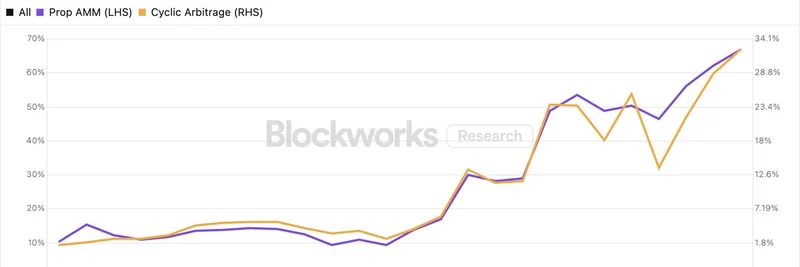In the fast-paced world of Solana's DeFi landscape, where meme tokens often explode in popularity overnight, liquidity is king. But there's a brewing debate about who really benefits from the current setup: professional market makers or everyday retail participants? A recent thread on X, amplified by the HawkFi team, dives deep into this, challenging the widespread belief that retail liquidity providers (LPs) are doomed to lose money.
The conversation kicked off with insights from Blockworks Research analyst Sharples, who pointed out how proprietary automated market makers (prop AMMs) are transforming arbitrage opportunities on Solana. Prop AMMs, unlike traditional passive AMMs, involve active quoting by professional firms, leading to tighter spreads and more atomic arbitrage between on-chain markets.
As seen in the chart above, the share of prop AMM volume has surged to over 70% of total DEX aggregator activity, with cyclic arbitrage following suit. This shift means better prices for traders, but it sparked questions about "toxic flow" – trades that might disadvantage on-chain liquidity providers.
HawkFi co-founder hawk jumped in, arguing that prop AMMs accelerate this toxic flow by siphoning profits off-chain. He emphasized that while prop AMMs offer superior pricing for blue-chip assets like SOL-USD, they undermine the goal of fully on-chain price discovery. For tail assets – think volatile meme tokens where hype drives prices – on-chain AMMs shine because discovery happens directly on the blockchain.
The debate heated up when StrategicHash claimed retail LPs "constantly lose money on passive LP pools because they have no clue how it works." This narrative, often backed by old studies on pairs like ETH-USDC, paints passive liquidity as a loser's game due to impermanent loss (IL) – the value erosion when asset prices diverge in a pool.
But hawk pushed back hard: "Will have to 100% disagree with you here." He highlighted how active LPs using platforms like Meteora's DLMM (Dynamic Liquidity Market Maker) and Orca are not only breaking even but outperforming IL. With precise liquidity concentration, dynamic fees, and automation tools like HawkFi, skilled providers treat LPing as a full-time gig.
"Active LPing can be reliably effective for profit making," hawk noted, pointing to communities like the Meteora LP Army as proof. HawkFi's metrics track user positions, showing consistent gains for those who rebalance smartly on DEXes like Raydium. This counters the "meme" that all LPs bleed money, especially when automation handles the heavy lifting.
From a meme token perspective, this is huge. Meme coins rely on robust, on-chain liquidity to handle wild swings without massive slippage. If prop AMMs dominate, retail LPs might get squeezed out, pushing more activity off-chain. But hawk envisions an endgame where advanced DEX architectures and active strategies let on-chain AMMs reclaim volume, keeping profits in the community.
HawkFi's quote tweet summed it up bluntly: "💀Toxic assumption that 'Retail Market Makers' cannot make money... as toxic as Prop AMM flows." It's a call to action for blockchain practitioners to level up their LP skills.
If you're dipping into Solana memes, understanding these dynamics can help you navigate trades better – or even become a profitable LP yourself. Tools like HawkFi make it accessible, turning what was once a pro-only game into something retail can win at.
For more on Solana's evolving DeFi scene and how it impacts meme tokens, stay tuned to Meme Insider.

